Its holdings of commercial paper & corporate bonds are nearly gone. The BOJ is cleaning up its balance sheet.
By Wolf Richter for WOLF STREET.
The Bank of Japan further accelerated its quantitative tightening: Total assets on its balance sheet fell by ¥22.3 trillion ($148 billion) in the quarter through September, the biggest quarter-over-quarter decline since QT started in early 2024.
Since the peak in the quarter through March 2024, total assets have fallen by ¥61.2 trillion ($407 billion), or by 8.1%, to ¥695 trillion ($4.62 trillion), back to where they’d first been at the end of 2020, according to the BOJ’s balance sheet.
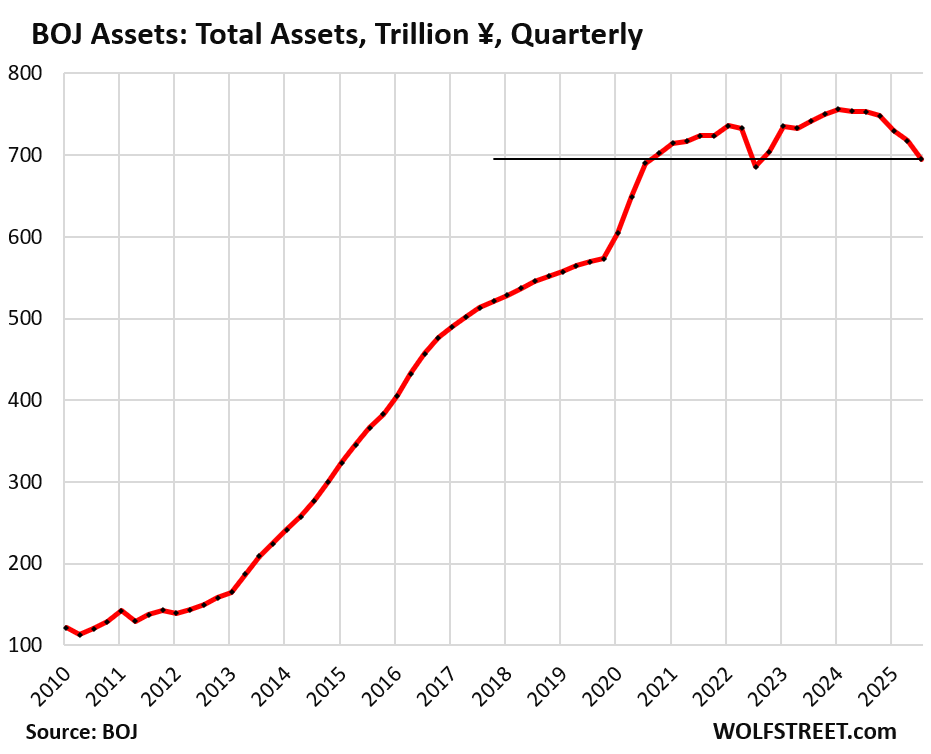
The BOJ fiscal year ends March 31. For the sake of simplicity, all quarters here are expressed calendar quarters (quarter ended September 30 = Q3).
Back in the QE days, the BOJ conducted QE in several forms:
- Japanese government securities (now 80% of total assets).
- Loans (now 11% of total assets).
- Stock-market traded equity ETFs and Japanese REITS (now 5% of total assets)
- Commercial paper and corporate bonds (down to 0.6% of total assets).
- Bank stocks purchased in 2000 and 2009 (sold the last ones in Q3).
Japanese government securities declined by ¥10.8 trillion (-$71.5 billion) in Q3, to ¥567 trillion ($3.66 trillion), the lowest since Q4 2022, down by ¥35.5 trillion (-6.0%) from the peak in Q4 2023.
Nearly all of them are longer-term Japanese Government Bonds (JGBs); its holdings of short-term Japanese Government Treasury Bills were unchanged at just ¥1.7 trillion ($12 billion).
The acceleration of QT, in terms of the quarter-over-quarter declines of its holdings of Japanese government securities:
- Q3 2025: -¥10.8 trillion
- Q2 2025: -¥8.4 trillion
- Q1 2025: -¥6.4 trillion
- Q4 2024: -¥3.1 trillion
- Q3 2024: -¥3.0 trillion
- Q2 2024: -¥1.2 trillion
- Q1 2024: -¥2.6 trillion
- Q4 2023: end of QE
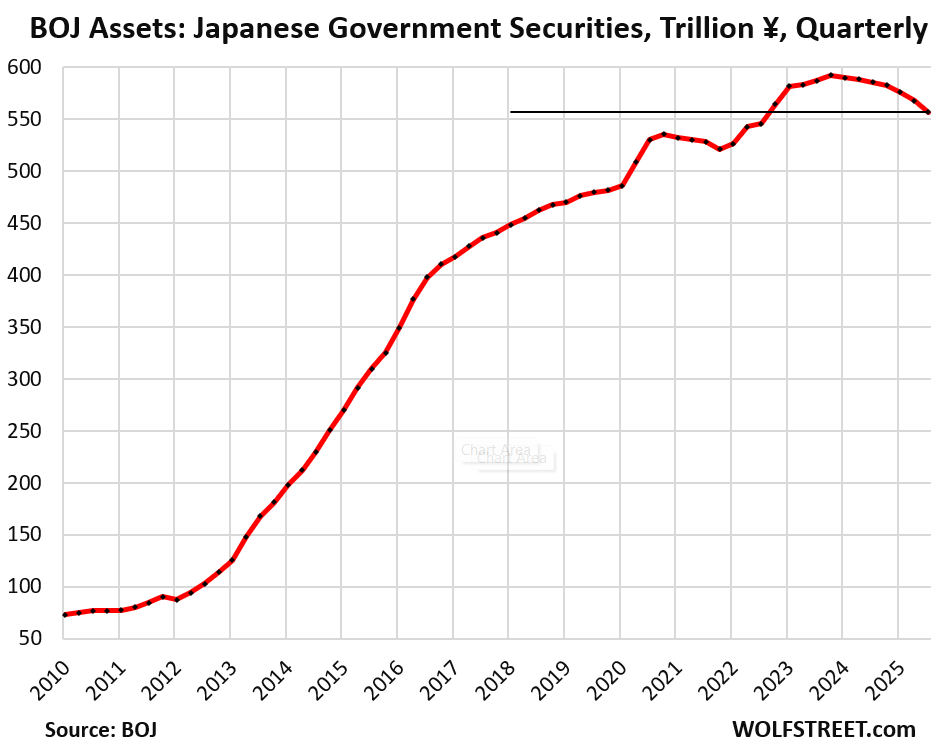
The BOJ’s holdings of Japanese government securities move in three-month cycles due to the timing of when long-term bonds mature and when they’re replaced with newly issued bonds of the same type. The BOJ also makes quarterly data available and refers to quarterly data in its balance sheet discussions, which iron out the three-month cycles.
Loans declined by ¥10.8 trillion in Q3 from Q2, and by ¥26.1 trillion year-over-year, to ¥83.8 trillion ($555 billion).
Since the peak in Q1 2022, the outstanding balance has fallen by ¥67.7 trillion, or by 45%.
These loans now account for 11% of the BOJ’s total assets. The BOJ provided loans to banks and other entities under several programs, including the pandemic-era loans that caused the total amount of loans outstanding to more than triple in two years:
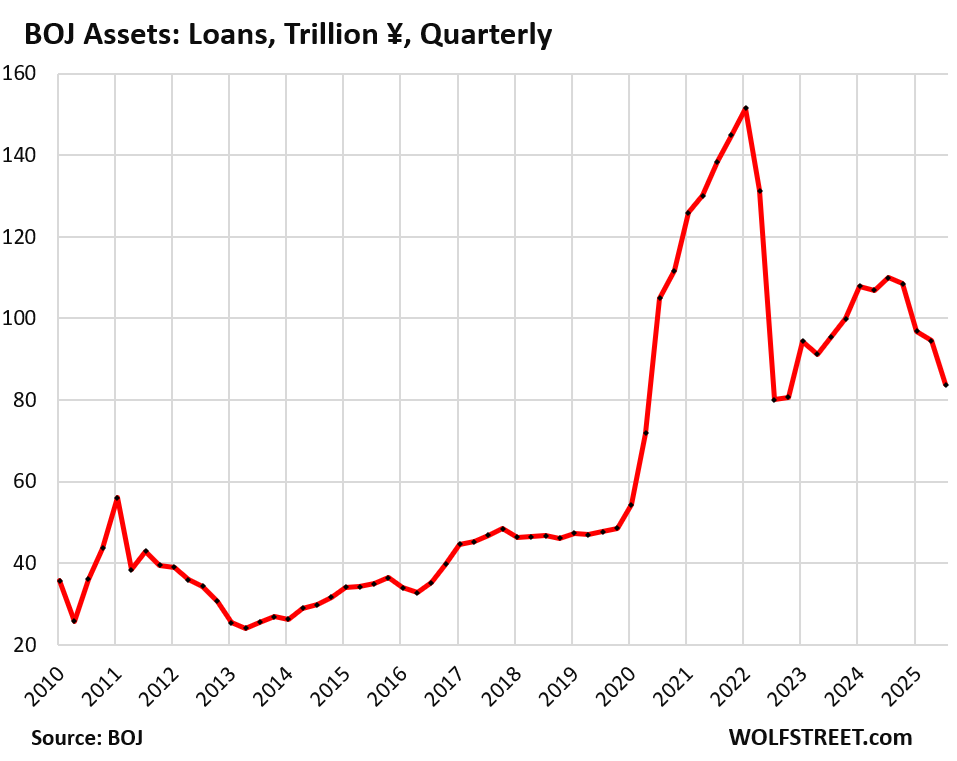
BOJ’s equity ETFs, Japanese J-REITs, and bank stocks.
Equity ETFs, Japanese REITs, and bank stocks don’t mature, and therefore the BOJ can’t get rid of them by letting them mature without replacement, unlike Japanese government securities, commercial paper, and corporate bonds. To get rid of its equity ETFs, Japanese REITs, and bank stocks, the BOJ has to sell them outright.
The BOJ is preparing to sell its ETFs and Japanese REITs, it said at its September meeting. It will start selling them at an initial pace that is very slow: equity ETFs at a pace of ¥330 billion per year ($2.2 billion) and Japanese REITs at a pace of ¥5 billion per year ($33 million).
It said that it could review the pace of those sales at future policy meetings. It said the sales would start when the operational preparations are completed.
The BOJ carries them at acquisition cost and didn’t write them up as market values rose since it started buying them in 2012. It stopped buying in Q4 2023 when they’d reached ¥37.8 trillion ($250 billion) at acquisition cost.
Equity ETFs and J-REITs only account for 5.0% of the BOJ’s total assets. They were always only a small part of the BOJ’s QE operations, but the hype around those purchases in the US QE-promoting financial media was enormous.
The BOJ sold off its last bank stocks in Q3. It had purchased them in the early 2000s and then again in 2009. The purchases of bank stocks ceased in 2010. In 2016, the BOJ started selling them and said at the time that sales would be completed by March 2026. As of the end of September, the last of the bank stocks were gone. This process can be a guideline for how the BOJ will sell its ETFs and J-REITs.
The BOJ’s total stock-market-traded assets combined – bank stocks, equity ETFs, and J-REITs – have declined since the peak in Q4 2023 at a microscopic pace, totaling 0.9%, due to the sales of the bank stocks. The decline is so small it gets lost in rounding.
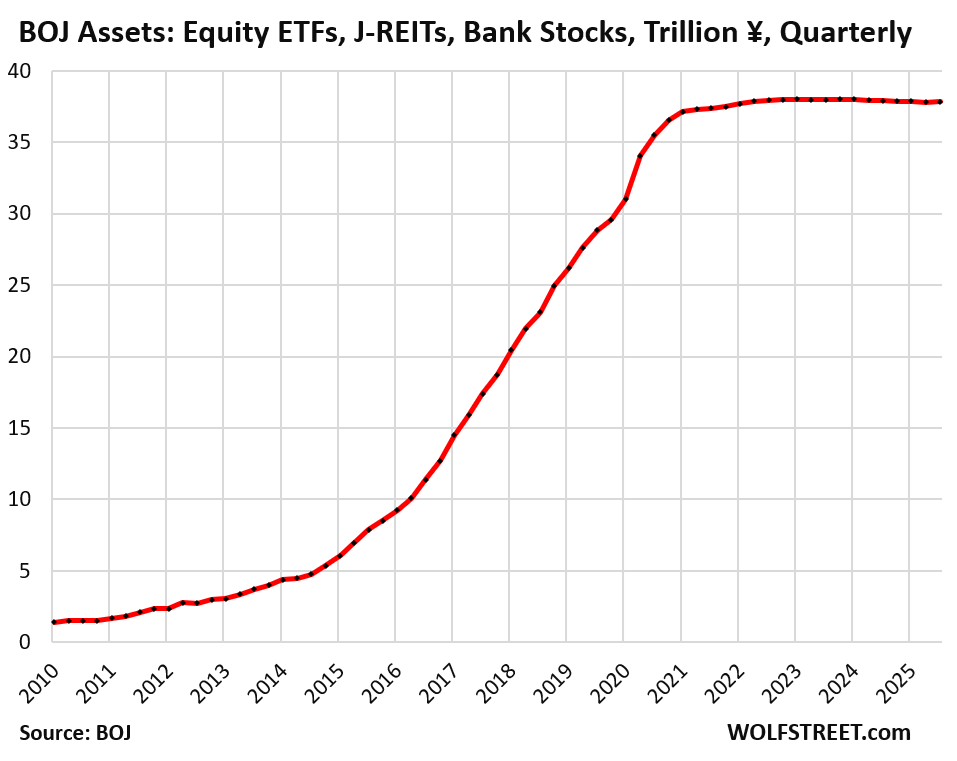
Commercial paper and corporate bonds fell by ¥1.0 trillion in Q3 to just ¥3.9 trillion ($26 billion), the lowest since 2012.
Since the peak in Q4 2021, they have plunged by 57%. The BOJ stopped buying commercial paper and corporate bonds in early 2022, and its holdings have been running off the balance sheet as they mature.
They were never a significant part of the BOJ’s QE operations. At their peak in Q4 2021, they accounted for only 2.2% of the BOJ’s total assets, and their share is now down to just 0.6%.
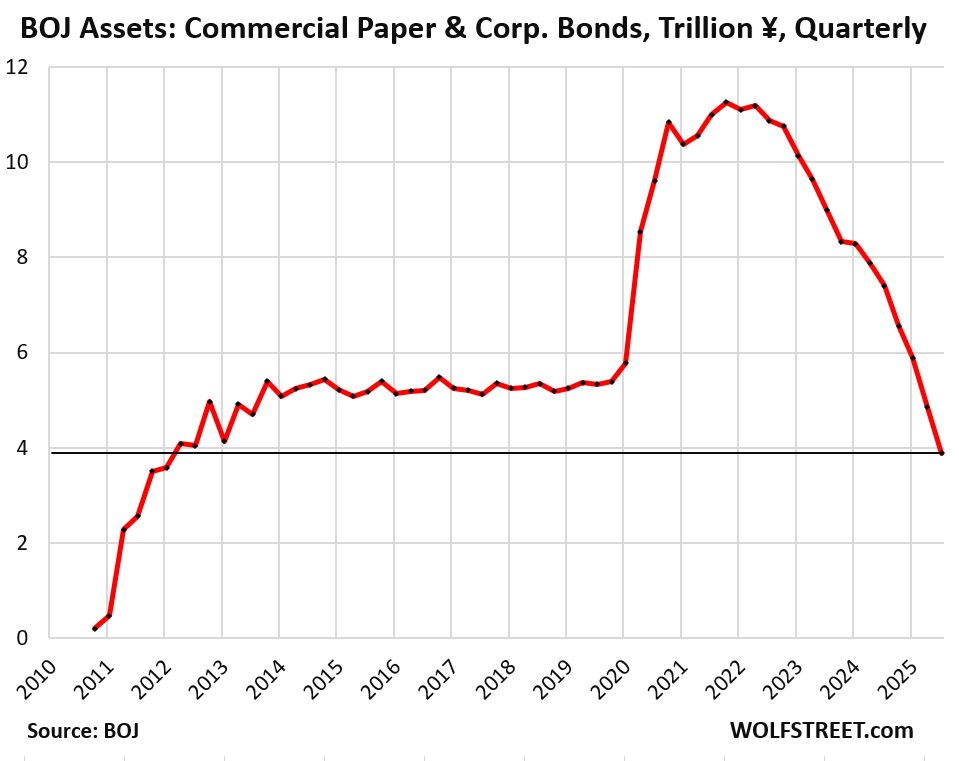
In case you missed it: Fed Balance Sheet QT: -$15 Billion in September, -$2.38 Trillion from Peak, to $6.59 Trillion.
Enjoy reading WOLF STREET and want to support it? You can donate. I appreciate it immensely. Click on the mug to find out how:
![]()


What have they done with the BoJ’s Gold reserves??? (if any)
Why would such a trivial little asset class like gold matter at all?
But now a female PM? There goes the country!
To be serious, both the UK and Germany have had good female leaders: Thatcher and Merkel.
I know a lot of lefty Brits didn’t like Thatcher but they forget the basket case she took over. Example: incredibly, the press unions had negotiated a ban on the intro of modern tech into printing newspapers. They were still melting hot metal being cast into letters on Linotype machines. After a page had been assembled in a box, a proof was taken. One man would roll ink over the letters, another would place a sheet of paper, a third would press the sheet. None could do another’s job: that would cause a strike.
Similar conditions in auto plants: one important plant only had two weeks of uninterrupted production in a year. Meanwhile, in 1974, W Germany, VW had its first strike. It lasted for one day.
Both women were scientists, Thatcher worked with X ray diffraction and did research for 3M, before becoming a lawyer, before becoming a politician. Merkel did nuclear physics as applied in reactors.
Let’s hope a female PM helps other women to breakthrough Japan’s very thick ‘Glass Ceiling’ in its business world.